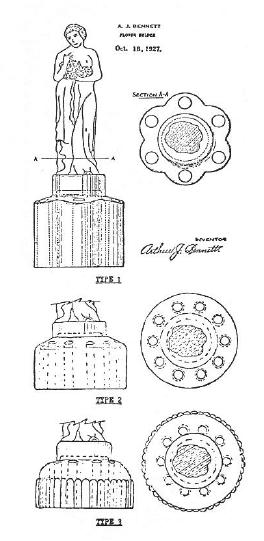Flower Holders
by Bill Smith
Issue #17 - September 1974
In the continuing effort to create in this publication something that is both beneficial and interesting to you that collect Cambridge glass, our President has requested that a column be written regarding the many flower frogs that were produced by the Cambridge company.
The dubious honor of providing this series of articles fell my way. This being the first of the series, I will attempt to explain what will be attempted and basic format to be used.
Utilizing many of the notes that are still to be found on the subject and many of the examples that are to be found in old catalogues of Cambridge, I will try to explain as many of the terms and variations of flower holders, or frogs, as I can, keeping in mind that as much of the information will be authenticated as is possible.
 Some of
the wording on Mr. A. J. Bennett's original patent application should
serve as a means of setting the trend in this discussion.
Some of
the wording on Mr. A. J. Bennett's original patent application should
serve as a means of setting the trend in this discussion.
This invention relates broadly to flower holders, and it has for its primary object to provide a novel and improved form of flower holding block of the general type employed in flower bowls, and embodying an integral ornamental statue or image.
He further stated - "What is claimed is ...
A flower holder comprising a base adapted for seating within a water containing bowl, and a statue-like image surmounting said base and said base having extending therethrough a plurality of substantially vertical bores adapted for the reception of the stems of cut flowers arranged in encircling and partially concealing relation to the image, said bores being of a length so as to hold the flower stems in a vertical position and extending thru the bottom of the base so as to enable the stems to seat on and be supported by the bottom of the bowl."
From this statement of his aims, we find a few facts that we can use. He does not state that any particular figure will be used in his invention. He only states "an ornamental statue or image". As we well know, he used many female forms as well as several other forms to express his ideas of ornamentation.
We further find, that he did not stipulate an exact number of bores, or holes, to be used in his invention. Only that they be vertical, and that they encircle the base.
These tolerances show up in many ways during the course of the manufacture of these desirable collectibles. With reference to the accompanying sketches, we can see how variety was achieved in the construction of the bases of these figure holders, and how there is also variety in the number of holes in the bases.
The three types of bases shown in sketches fairly well represent the evolution of variety in the shape, with "Type I" being the older of the three end "Type 3" the latest. It may be of interest also that all the known holders that have been produced by Imperial Glass Company have been of the "Type 3" base.
As of this writing, I have not been able to locate a Cambridge catalog number used for the figure in the sketch. Some say that this lady was the first to be produced by Cambridge. I am inclined to agree with this theory on the fact that she was represented on the patent application. She is sometimes called the "Flower-Lady" and sometimes the "Rose-lady".
Additional variety will be discussed later in other articles dealing with the dimensions, colors, and other specific details of some of the various figures.
